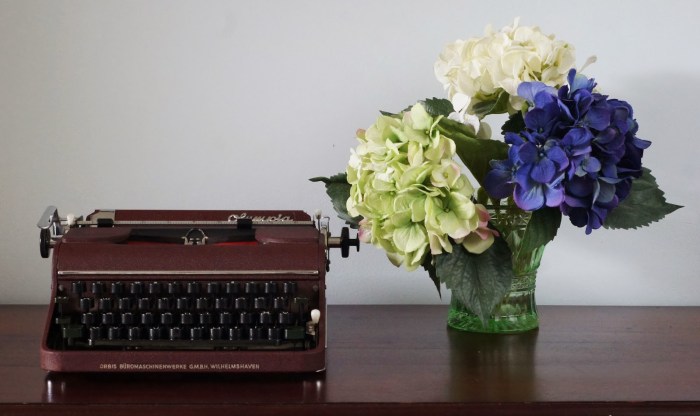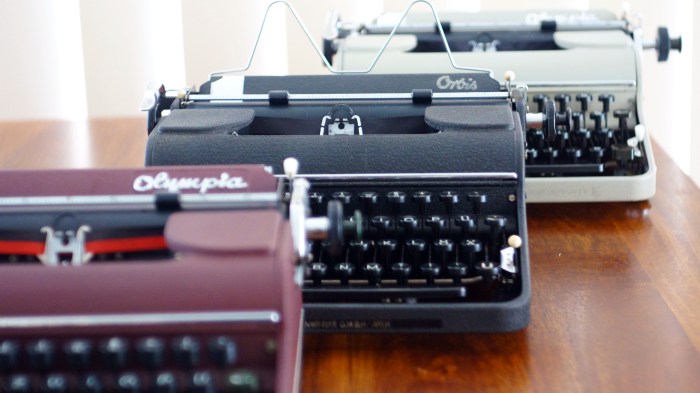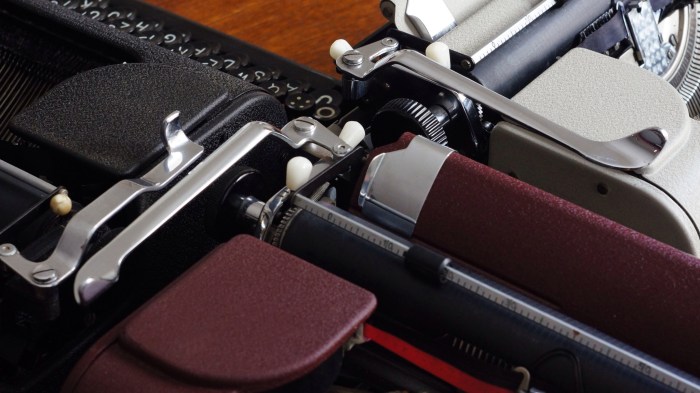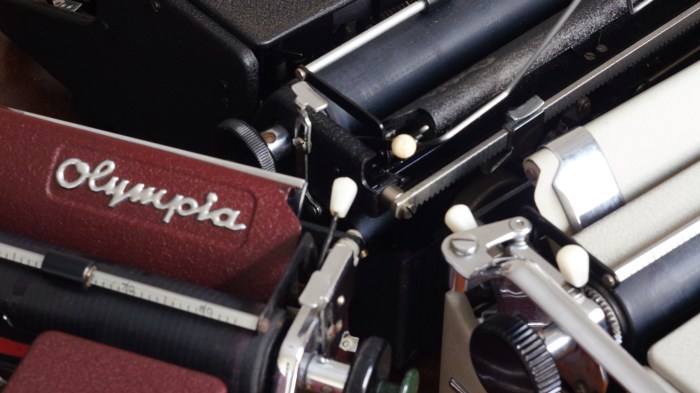I’m on dangerous ground here. For the last 6 months I have been largely concentrating my collecting activity on German machines – specifically Olympias, and I have been trawling ebay.de looking for specific typewriters for my collection. However, focusing on Olympias has introduced me to some interesting aspects of the history of their machines, which has subsequently revealed some interesting, significant and occasionally rare machines. This was most realised recently when I got my hands on the Commando Modell A.
That said however, my interest in the ‘thin in numbers’ and rare machines belonging to the Olympia family had really started further back last year, when I got hold of a particular machine of interest.
The machine that started this all was an machine that bared the Olympia badge, but for all intents and purposes was otherwise identified as an ‘Orbis’. My blog entry on this machine can be found HERE.
At the time I did a fair bit of research into this Orbis name, but didn’t come to any solid conclusions about my particular typewriter. However, during my research I discovered another Orbis out there that had been badged as an ‘Orbis’, with not a single mention of the name Olympia on the machine at all. Those Orbis machines were a limited run that were produced only during the year 1949, while a legal battle was fought over the ‘Olympia’ name between companies in east and west Germany.
At the time I reviewed that machine I became eager to get my hands one of those particular Orbis machine. With only 12,300 of them made I knew they aren’t so rare for this to be an impossible task, but would require a good bit of hunting. After all, while there were 122,786 SM1s made – they don’t exactly seem to be all that easy to find, especially in Australia. So I kept an eye on German ebay and continued to search for months after. I wrote that blog. My first chance came up earlier this year when I spotted one, but was sadly outbid. I then felt almost tormented when I saw Vilhelm Dromberg post a machine up onto the Typewriter Database that I was almost certain was the machine I had missed out on.
I didn’t despair, and I kept on hunting. Only to be surprised by the sudden appearance of 3 such machines on ebay.de in quick succession.
I bid on two and waited, while gnawing at my finger-nails. Eventually I was successful with the first that I bid on, and I soon organised for this machine to be posted over to me here in Australia. Oddly enough, every machine that I have spotted was only for sale for post to Germany, but I’ve found a couple of methods to get around that. It wasn’t long before I had a notification from DHL.de that my typewriter was on its way to me, and I was very excited.
However, post between Germany and Australia via DHL post is frustratingly slow. I had paid for the typewriter while I was still in Queensland, and it wasn’t until around the second month anniversary of my new job that I actually had the machine in my hands.
So it is without further ado that I present: The Orbis. Serial # 6896
The cardboard box it was packed in somehow got mangled during the long trip, implying that the machine may not come out of the box in particularly good condition. So I cautiously, but excitedly, ripped the packaging off. Inside I found a completely intact case, containing a typewriter that had been cling-wrapped to perfection. Oh yes. I had my Orbis, and I was a happy, happy man.
For the sake of clarification, I’ll here on refer to the three Olympias by the Following names: The black (as depicted below) as ‘The Orbis’. The Maroon as ‘The Orbis-Olympia’, and the Sandy coloured machine as ‘The SM1’.
Previously I documented that there were several differences between the Orbis-Olympia and the SM1. Just to make things complicated, the Orbis has several further differences.
The first, and most obvious difference is the branding. While the later two machines have a proudly chromed Olympia badge sitting in a recessed oblong on the paper-table, the Orbis branding is a decal applied to a flat paper-table. However, the decal across the front of the Orbis is the same as the Orbis-Olympia. Although the decal on the Orbis had been partially scrubbed out, and I needed to use a black-light to confirm that it was indeed the same.
The lack of chrome flourishing doesn’t just end there. The Orbis lacks the chrome stripe down the side, along with the chromed carriage ends. Additionally the Orbis also lacks the chromed skirting that surrounds the rubber feet under the typewriter that the other two have.
The paintwork is also quite interesting. It is hard to tell in the photos, but the crinkle paint is rougher and has much more of an industrial feeling. It is also an incredibly black to see in person, and makes the other crinkle black machines of its era look more of a dark grey.
Another interesting feature is the difference in the keyboard. The Orbis uses a simpler design to that the later two, with only round shift keys that are identical to the kind found on pre-war Olympia portables. There’s none of that silly green finger shaped key business on this machine, unlike the other two. That said, the rest of the keys on the Orbis match the SM1 and not the thicker high-set keys of the Orbis-Olympia which were made to accommodate springs.
The platen knobs are the same shape as the Orbis-Olympia, but the Orbis doesn’t share the same green platen release knob.
While the Orbis-Olympia and the SM1 share the same flip-up paper finger, the Orbis retains the zig-zag wire arrangement that was in use on a lot of the pre-war Olympias.
The Orbis also has a very different carriage lever than the other two, and is equipped with a stubbier and more articulated design that was occasionally sighted on pre-war machines.
Sadly the Orbis’s manufacturing tag has been covered by a dealer’s label, and I can’t see if there is a similarity between the label on this machine and the one found on the Orbis-Olympia. However, while looking behind the machine I found that the Orbis’s Margin rack was chromed, whereas the other two machines were a powder coated black. However, while the other two had exposed steel ball-bearing travel rails, the Orbis’s are black.
Interestingly, the Orbis’s carriage is by far the smoother of the three, and it has a slightly different escapement setup that trips the escapement dog out of the way when returning the carriage, rather than relying the spring pull system that is used on the other two. As such the Orbis feels almost freakishly smooth when you operate the carriage and reminds me of the later Triumph/Adler and Hermes machines rather than the latter Olympias in my collection.
While the Orbis also has the plastic knobs on the end of each lever like the other two machines, they are significantly smaller, and appear to be just balls of plastic which were melted onto the metal.
That said, despite having less in the way of flashy chrome adornments, the Orbis wasn’t a machine that was made on the cheep. The build quality is excellent, and is really shows that the company were determined to pull themselves out of the rubble of the second world war. The key action is precise, and I doubt that it has degraded much since the day that it was made. It still feels new and unworn after all these years, despite there being signs that this typewriter has had a reasonable amount of use.
Earlier I said I was entering dangerous territory with these typewriters – or more specifically while I was shopping on ebay.de. Not long after I discovered that I had successfully won the bidding on the first Orbis, I won the second unit at an uncontested and weirdly cheap price. The typewriter hasn’t made it to me as yet, and the DHL parcel tracking implies that it has been stuck at Australian Quarantine and Customs for a little while now. Someone has probably tried packing the machine in a fruit box again, which usually prompts customs to remove the packaging and destroy it. Hopefully without destroying the typewriter.
Either way, I’m going to have two of these machines in collection sometime soon. What on earth will I do with it.











Orbis marque added to the Database (:
LikeLike
Great! I better get my arse over there and ‘reclassify’ my typewriter!
LikeLike
Beautifully photographed; now you need to find a pre-war Olympia Super/Elite and compare with the Orbis!
Meanwhile I’m still trying to just find myself one SM1.
LikeLike
Thanks! I actually have a progress, Simplex and Elite to compare them to. Just currently in storage.
As for the SM1, they are surprising hard, hey!
LikeLike
Congratulations! Sounds like a fine machine.
LikeLike
Thanks. Pretty happy to get it!
LikeLike
Congrats! First time for me to hear of an Orbis.
LikeLike
Thanks!
LikeLike
What a great trio! Who knows, maybe your second Orbis will have more variations. Are there any other possible permutations, I wonder, like an “Optima Orbis” for example?
LikeLike
Yeah… Still wondering where my machine us…
LikeLike
Really nice photography there Scott! And an amazing looking trio too.
LikeLike
Quite happy with these little beasties.
LikeLike
Those are very interesting typewriters and I agree fine photos.
LikeLike
And thanks!
LikeLike
Nicely explained, I am now wiser about Olympia than I ever was before. And I am going downstairs to find me an Orbis, I must have one somewhere!!.
LikeLike
Thanks john! I’d love to hear that you have one.
LikeLike
HI Scott. This is the second time I have read this post. I originally read it after receiving my own Olympia-Orbis, with a wire paper support like your Orbis has… Now, I anxiously await my Orbis 6586 to arrive at the end of the week. Then I will have a nice collection with the Orbis, Olympia-Orbis, Olympia SM1, a beautiful SM2 with elite type, followed by my SM3s, 4s, a first generation Monica, and a blue SM7. Can you tell that Olympia has a special place in my world? 🙂 Thank you for your incredible work toward educating others on this passion of yours.
LikeLike
Thank you for your very kind words! Also, please! I would love to see a photo of your machine.
LikeLike